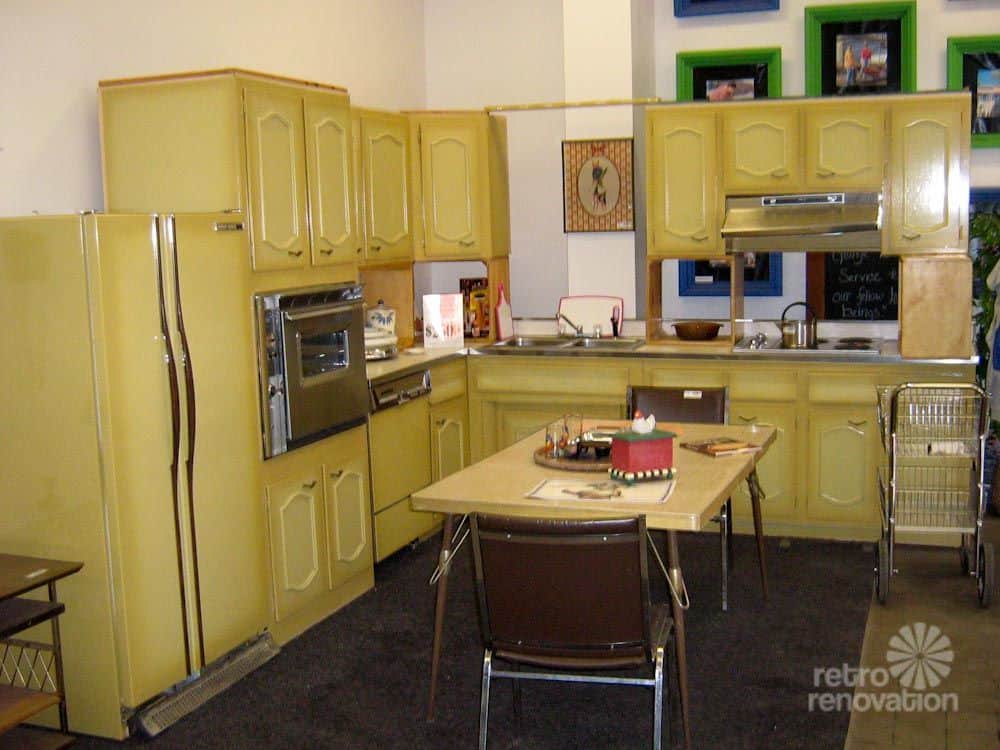Harvest Gold was a popular appliance color in the late 1960s and 1970s. It was a warm, golden yellow hue that gave kitchens a retro, vintage look. Harvest Gold appliances were first introduced by General Electric in 1967 and quickly became one of the most fashionable appliance colors of the time period. The warm, earthy tone was meant to evoke feelings of autumn and the harvest season. In this article, we’ll take a closer look at the history of Harvest Gold appliances, when they were most popular, and some of the most common appliance models that came in this distinctive color.
The Introduction of Harvest Gold Appliances
In the 1960s, kitchen appliance colors were fairly limited and utilitarian. White and off-white were the most common colors for major appliances like refrigerators, ranges, and dishwashers. Some brands also offered these appliances in basic pastel colors like pink, turquoise, light blue, and yellow. However, these appliance colors didn’t offer much in the way of style or visual interest.
General Electric sought to change that in 1967 when they introduced a new color called Harvest Gold to their appliance line. It was a warm, golden-yellow hue that was deeper and more vibrant than the pale yellow appliances previously offered. The rich, golden tone was inspired by the colors of fall and was meant to add a touch of nature and seasonality to appliance design.
Harvest Gold was an immediate hit with consumers and quickly shot to popularity as one of the most fashionable kitchen appliance colors of the late 1960s and 1970s. The public embraced the warm, earthy tone that felt both retro and modern at the same time.
The Height of Popularity in the 1970s
The use of Harvest Gold appliances peaked in the early to mid-1970s. By this time, all the major appliance manufacturers like General Electric, Frigidaire, Kenmore, Whirlpool, and others were offering models in Harvest Gold. Refrigerators, stoves, dishwashers, microwaves and other appliances were produced in this shade.
In 1970, over one million Harvest Gold appliances were sold. The color was especially popular for refrigerators, which were a focal point of most kitchens. The warm golden tone paired well with wood cabinetry and fit right in with the aesthetic of the time period.
By the mid-1970s, Harvest Gold was by far the dominant kitchen appliance color. One industry survey from 1974 showed that 63% of all major appliance purchases that year were in Harvest Gold. Avocado Green came in a distant second at 11% in the same survey.
The color maintained its popularity through the rest of the 1970s. However, by the very late 70s, more neutral tones like almond, brown, and white started gaining ground. The harvest gold trend was clearly winding down as the 80s approached.
Most Common Harvest Gold Appliance Models
Many appliances came in Harvest Gold during the late 60s and 70s. Here are some of the most popular models from major brands:
Refrigerators
– Kenmore Gold Medallion refrigerator
– Fridgidaire Gold Line refrigerator
– General Electric Gold Reefer refrigerator
Ranges
– General Electric Gold’N Hot range
– Frigidaire Gold’N Sizzle range
– Kenmore Golden Touch range
Dishwashers
– General Electric Gold Series dishwasher
– Whirlpool Gold Line dishwasher
– Kenmore Golden Ultra Wash dishwasher
Microwaves
– Kenmore Gold Standard microwave
– General Electric Gold Line microwave
– Frigidaire Gold Crown microwave
Decline in Popularity in the 1980s
By the early 1980s, the popularity of Harvest Gold appliances was clearly on the decline. The new decade ushered in a shift towards more neutral, modern, and streamlined kitchen designs. The warm, retro Harvest Gold tone began to feel dated and out of style.
While Harvest Gold appliances were still available into the 80s, they represented a shrinking portion of sales. By 1985, less than 12% of major appliance purchases were in Harvest Gold. White, almond, and other neutral tones became the preference for most consumers’ kitchen aesthetics.
The final death knell for Harvest Gold came in the late 1980s as more high-tech black and stainless steel appliances grew in popularity. The vintage vibe of Harvest Gold no longer aligned with contemporary kitchen designs. While the color had an impressive 15 year reign, its popularity faded by 1990.
Revivals and Collectability
While no longer mainstream, Harvest Gold appliances can still be spotted in some retro-styled kitchens. Minor revivals of the color occurred in the 1990s and early 2000s, often in association with mid-century modern decor.
For collectors and antique dealers, vintage Harvest Gold appliances from the 1960s and 70s can command high prices. The old appliances in Harvest Gold and similar vintage colors like Avocado Green and Poppy Red are prime examples of kitschy retro design. Fully functional Harvest Gold appliances from the peak era can sell for hundreds or even thousands of dollars to enthusiasts decorating in a retro style.
The warm, golden glow of Harvest Gold kitchen appliances represents a significant design trend that defined its era. While no longer common in today’s kitchens, Harvest Gold still evokes nostalgic feelings and memories for many who lived through its widespread popularity in the late 20th century.
Conclusion
In summary, Harvest Gold was one of the most fashionable appliance colors from the late 1960s through the 1970s. General Electric first introduced the distinctive golden-yellow hue in 1967. The color reached peak popularity in the early to mid-1970s when over 60% of appliance sales were in Harvest Gold. All the major brands like GE, Kenmore, Whirlpool, and Frigidaire offered refrigerators, ranges, dishwashers, and microwaves in this shade. However, Harvest Gold declined significantly in the 1980s as neutral and high-tech appliance colors came into fashion. While no longer mainstream, vintage Harvest Gold appliances from the 1960s and 1970s era are collectible and valued for their retro design aesthetic. The warm, rich tone remains tied to happy memories and nostalgia around kitchen design for many who lived through its heyday.


